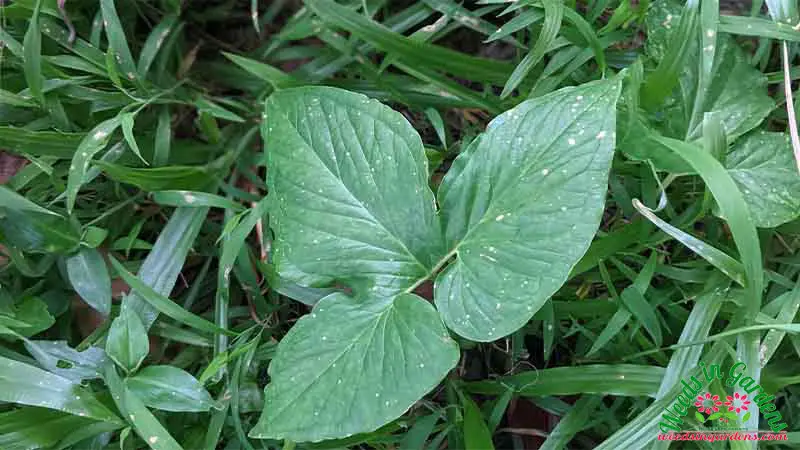In South Asian countries e.g., Bangladesh and India, a plant with a unique leaf structure is found. It seems like three leaves are attached to form a single leaf. This plant is Bengal Arum (Scientific name: Typhonium trilobatum). In my country, Bangladesh Typhonium trilobatum is commonly known as ‘Kharkon’, ‘Ghat kachu’, or ‘Ghatkol’. In Bengali, ‘kachu’ is the common name for all aroids. So, you can understand that Bengal Arum belongs to the family Araceae. This perennial plant has some traditional medicinal uses. So, its toxicity and medicinal values should be explored more by scientists.

Habitat
Bengal Arum is mainly found in South Asian countries viz. Bangladesh, India, Nepal, Sri Lanka, and Thailand. This plant is also found in China, Vietnam, and Australia.
This plant is found in forests, grasslands, and roadsides.
Common names
Typhonium trilobatum is also known as ‘Arum trilobatum’, ‘Arum orixense’.
Some other common names of Bengal Arum include Lobed Leaf Typhonium, Ghat kanchu/ Ghat kachu, Kharkol, Kharkon, Ghatkol, Ghet kachu/ Ghet kanchu, chema kachu, Panu ala etc.
Family
Bengal Arum is in the arum family, Araceae.
Leaves
Color: Green
Unique character: Trilobed leaves
Shape: Central lobe of the leaf is ovate. The side lobes are smaller than the central one.
Flower
Bengal Arum has Spadix Inflorescence.
Flower color: reddish-purple
Fruits
Fruits of Bengal Arum are berries.
Fruit color: Green, have purple dots. Mature fruits are white.
Seed: Each fruit contains 1 to 2 seeds.
Medicinal values of Bengal Arum
- Treatment of Dyspepsia: In case of indigestion, we often feel stomach pain. Which sometimes felt like over-fullness in the stomach and bloating. These conditions are called Dyspepsia. Typhonium trilobatum L. Schott or Bengal Arum has traditional use to treat Dyspepsia.
- Anti-diarrheal use: Bengal Arum has traditional medicinal use to treat diarrhea also.
- Treating piles: It is heard that Bengal Arum helps to treat piles or Haemorrhoids.
- Analgesic use: Leaf extract of Bangal Arum is used traditionally by some Asian people to get relief from pain and swelling.
- Anti-ulcerogenic use: It is believed that Bengal Arum has anti-ulcerogenic effects.
Toxicity
Typhonium trilobatum contains calcium oxalate crystals in its body. The most concentration of this toxin is found in tubers/corms (/aroid roots).
Bengal Arum toxicity causes-
- Acute pain in the oral cavity
- Breathing difficulties/ discomfort (upper airway compromise, respiratory distress)
- High heart rate
- Higher blood pressure
- Swollen lips
- Swollen tongue
- Saliva drooling/ increased salivation
These signs and symptoms may appear within 10 to 15 minutes of consuming Typhonium trilobatum. So, stay away from consuming this plant by yourself.
Calcium oxalate forms oxalic acid in blood streams and sediments in the liver, heart, lungs, and kidney. So, to save these organs, avoid taking Bengal Arum.
Control
Bengal Arum is hard to control as it has an underground corm (tuber). To effectively control this plant, underground parts have to be removed.
Taxonomic classification of Bengal Arum
- Kingdom: Plantae
- Phylum: Spermatophyta
- Subphylum: Angiospermae
- Class: Monocotyledonae
- Order: Alismatales
- Family: Araceae
- Sub-family: Aroideae
- Genus: Typhonium
- Species: T. trilobatum
